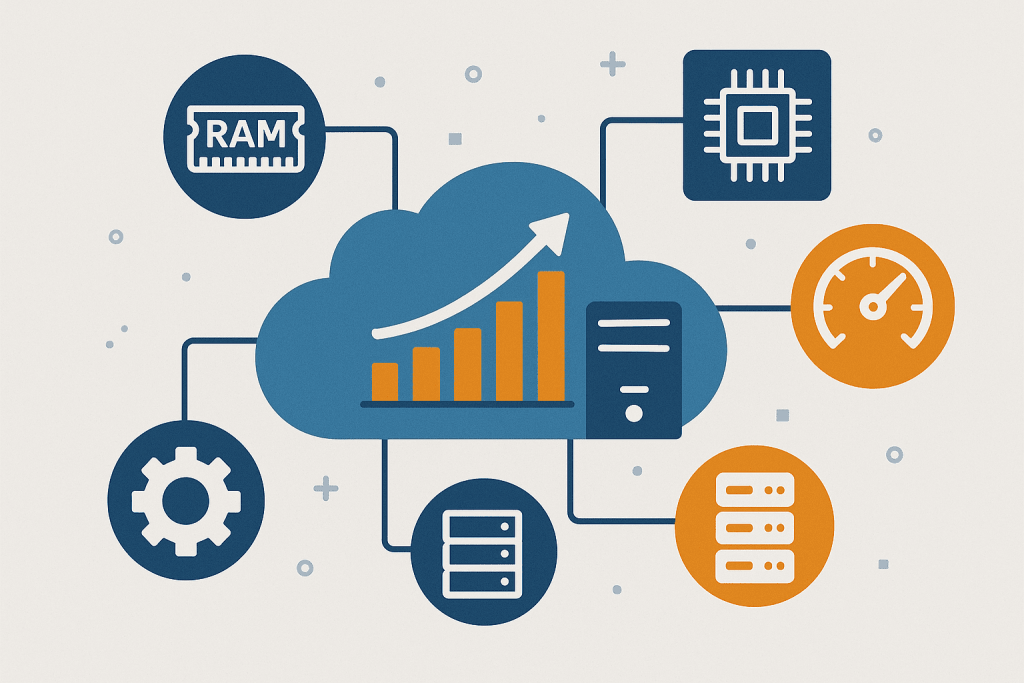
A virtual private server (VPS) is like a personal computer in the cloud that operates on a shared physical server but has its own dedicated resources: processor, memory, storage, and operating system. The way these resources are configured, distributed, and utilized directly affects how fast and stable your website or application will run. Let’s take a closer look at what influences VPS performance and what each key component means.
Processor (CPU)
The CPU is the main “brain” of the server that performs all calculations. The number of cores determines how many tasks your VPS can handle simultaneously. Clock speed (measured in gigahertz) shows how quickly the processor can process data. The more modern the CPU, the faster it responds to requests — such as generating web pages, processing database queries, or running APIs. Hosting providers that use newer processors (for example, the AMD EPYC or Intel Xeon Scalable series) often deliver higher performance per core, resulting in faster response times even under heavy load.
Random Access Memory (RAM)
RAM is the “workspace” of your server. It temporarily stores data the system is currently working with — open files, queries, cache, and background processes. If there isn’t enough memory, the server starts writing part of the data to disk (swap), which drastically slows down performance. For CMSs, databases, and websites, the amount of RAM determines how many users your VPS can serve simultaneously without delays. The more memory you have, the more efficiently the system handles peak loads.
Data Storage (HDD / SSD / NVMe)
The disk is where all files are physically stored — from system libraries to images, databases, and logs. HDDs, the older mechanical drives, have long been replaced by SSDs, which use flash memory and provide significantly faster read/write speeds. NVMe (Non-Volatile Memory Express) is an even newer type of SSD connected directly to the PCI Express bus, offering minimal latency and the ability to transfer gigabytes of data per second. For websites with large databases, online stores, or CRM systems, disk speed is crucial — it directly impacts how fast each page loads.
Virtualization Technology
Virtualization technology makes it possible to create multiple VPS instances on a single physical server. The hypervisor is the software that divides and manages these resources between virtual machines. There are different types of virtualization:
- KVM (Kernel-based Virtual Machine) provides full isolation, where each VPS has its own operating system and kernel — essentially functioning like a separate physical server.
- OpenVZ or LXC are lighter alternatives in which several VPS instances share a single system kernel. These setups perform faster but are less flexible — you cannot modify the kernel or install a custom OS.
The type of virtualization affects stability, security, and software compatibility. KVM is typically chosen for professional and high-load projects.
Network Infrastructure
Network infrastructure determines how quickly your server exchanges data with the internet. This includes the physical network connection (fiber-optic channels, bandwidth capacity in gigabits) and routing quality (how efficiently data packets reach users). For globally oriented websites, data center location is key — the closer the server is to users, the lower the ping (response latency). For instance, if your audience is in Ukraine, it’s logical to choose a VPS hosted in a Kyiv data center rather than in the U.S. Additional technologies like CDN (Content Delivery Network) and Anycast DNS also improve speed by reducing the distance data must travel.
Operating System (OS)
The OS determines how the server manages resources, security, and applications. Most VPS servers run on Linux (Ubuntu, Debian, CentOS, AlmaLinux), while Windows Server is used less frequently. Linux generally consumes fewer resources and offers flexible configuration options, making it ideal for most web projects. Windows, however, is more convenient for corporate environments or cases requiring integration with Microsoft products. Regardless of the system, it’s crucial to install updates regularly, optimize the kernel, and disable unnecessary services — all of which directly affect VPS stability and performance.
Software Environment
The software environment includes everything that runs on top of the OS: web servers (Apache, Nginx, LiteSpeed), databases (MySQL, PostgreSQL, Redis), and scripting interpreters (PHP, Python, Node.js). Their configuration has a tremendous impact on performance. For example, misconfigured caching or PHP limits can create bottlenecks even on a powerful server. Optimizing configurations, enabling page and database caching, and using CDNs can multiply performance without upgrading your plan.
Monitoring and Load
Even a perfectly configured VPS needs monitoring. If you don’t track CPU, RAM, disk, and network usage, your server may become unstable without obvious reasons. Monitoring tools (such as Grafana, Prometheus, Netdata, etc.) help detect issues before users experience slowdowns. It’s also important to analyze the type of load — steady or peak. For instance, if your site experiences traffic spikes during promotions, you should have a resource buffer or the ability to scale quickly to prevent downtime at critical moments.
The Key to Speed
VPS performance is the result of harmony between all its components — processor, memory, disk, network, and software environment. Each element plays a vital role, and only a balanced configuration ensures fast, stable, and secure operation. On RX-NAME, you can choose a VPS with the exact parameters you need — including SSD, NVMe, or HDD storage — for any purpose, from small websites to large-scale online projects.

Leave a Reply